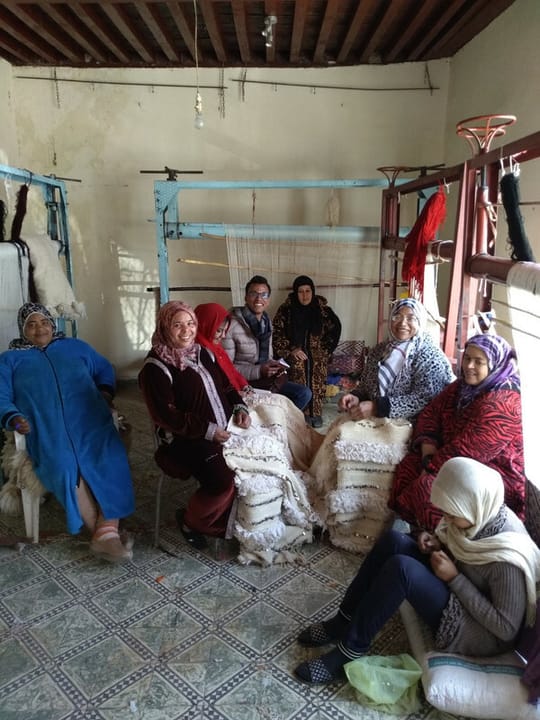The Moroccan Schools as Bridge to the Communities


The beauty of Morocco exists not only in the big cities but also in the charming villages of the countryside. Many villages and residential communities are scattered along the Atlas Mountain range, from the south-west of the country to the far east, and the activities vary from one region to the other. Nevertheless, they share many activities and practices.
Since 2000, the High Atlas Foundation (HAF) has been trying to reach and visit as many villages in Morocco as it can, to work with communities to improve development by creating sustainable projects using different methods of communication.
HAF did a lot of work across the High Atlas Mountains, in Al Haouz, Ouarzazate, Taroudant, Errachidia, and in the Fès-Meknes region. The Delegation of Education in Ifrane is one important partner of HAF in the Fès-Meknes region. Together they decided to build fruitful partnerships and facilitate communication between all development actors in the Ifrane. Two years after this decision Ifrane’s Delegation of Education and HAF are very proud of the successful implementation of two fruit tree nurseries in the Assalam school and in the Al Akhawayn University in Ifrane. Driven by this success Ifrane’s Delegation of Education and HAF are now planning to expand this project and build another tree nursery in one of the schools of Ain Leuh, a small town located in the center of the Middle Atlas Mountains, about 1450 meters in altitude, and about 28 kilometers from Azrou.
Said Bennani and the HAF nursery caretaker in Ifrane nurseries traveled from Ifrane to Ain Leuh to visit the schools and meet local communities. We were welcomed warmly by a local teacher of Atlas primary school in Ain Leuh. The teacher was happy to talk with us about her village and the primary school she studied in, when she was a little girl! Now she is a prominent woman in her town – she in not only a teacher but also a leader and contact person for all women in the region, who face challenges. The teacher did not hesitate to show us most of the school parts and share with us information about the history and the students who are studying there.

The school was established a long time ago, likely in 1923. It is quite large with 12 classrooms, and new ones have yet to be completed. Moreover, they have free space that they can utilize, if they gave it more attention. We also saw existing trees in the school, while we were there. They had many local types of fruit trees as well as some forestry trees. Moreover, the free land they have is not quite big enough to think about building a new fruit tree nursery. Nevertheless, the teacher spoke on behalf of many local actors there—cooperatives, associations, and the agriculture center—who are working together to make their primary school shinier and engaging the community in the development of their own projects. In addition, HAF are looking as well to join this group of actors to talk more about their interest and the possibilities of how we can create more development projects in the communities. In the school, they have a water canal passing its square, plus a local small well. In addition, the teacher said that they are interested in putting an aromatic and medicinal plants nursery in the school. They have bathrooms and a library with books, which gives me the impression that there are some people in that school or somewhere in the village that are looking to give more to Ain Leuh.


On the same day, I had the chance to visit a local cooperative, which makes wool carpets. In 2015, while I was a volunteer with the agriculture office in Marrakech, I worked with the same cooperative to accompany a group of women from Al Haouz, to visit many sites, in the north of Morocco, granting them more opportunities to learn from different experiences. I remembered the first time I visited them and how they were very active collective women making a variety of beautiful handmade wool carpets.
At the same time, I remembered one of the women from the same cooperative in Ain Leuh visited the HAF office two years ago, when I was a volunteer with HAF. In addition, she participated with Amina EL Hajjami, the HAF Project Manager for Women’s Cooperatives, in visits from the north of Morocco to the South. I visited again the women’s workshop for wool carpets as HAF Project Manager in Fes and Ifrane region. We talked about their challenges, and the future of the cooperative, as well as how they continue to grow the cooperative. Their first interest was looking for help to repair their workplace because the water used to leak inside of the building, preventing them from working comfortably during the rainy and snowy season. They said, “When it is raining, we are not working! Each one of us prefer to stay home.” HAF is looking to help cooperatives like these to solve their problems—community mapping is the best way to achieve this by engaging all the cooperative members.

My last activity before returning to Fez was the visit I had to the Salam School fruit tree nursery. We met with Al Akhawayn university students and the new director of the school to make plans to organize a tree planting event with the local schools and communities in the next two months. Thank you to all HAF partners in Ifrane and Fes region, thank you to Ecosia who founded the fruit tree nursery for the Moroccan communities.